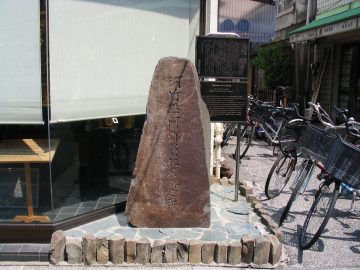
01. Monument of Kawatake Mokuami and Asakusa
2 chome 36, Asakusa
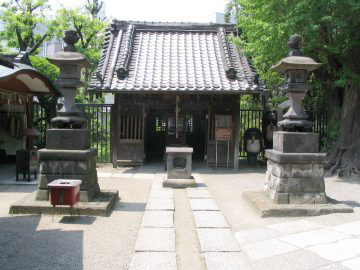
02. Chingo-do
Senso-ji Temple, 2 chome 3, Asakusa
Chingo-do is also known as "Otanuki-sama (Sir Raccoon-dog) " and is famous for being the deity of protection against fire and theft as well as flourishing businesses.
In 1872, a steward of Senso-ji Temple consulted with the chief priest of the temple and enshrined the deity in his own garden in order to prevent mischief by raccoon dogs that had taken up residence in Senso-ji Temple. This is said to mark the start of the history of the shrine as well as the origin of the name "Otanuki-sama." In 1883, the shrine was moved to the current location and the shrine building was constructed.
The current main shrine was rebuilt in 1913 and festival rites are conducted on March 17 and 18 every year.
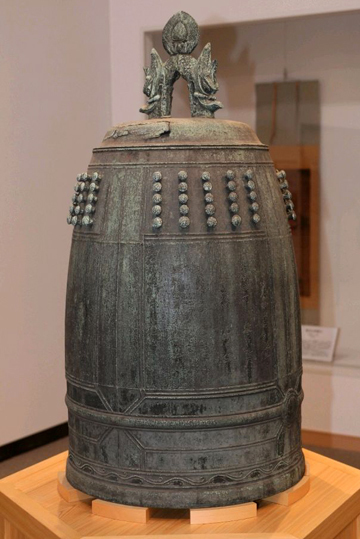
03. Old Bell of Sitoku
Senso-ji Temple, 2 chome 3, Asakusa
This bell was cast in 1387 and is called "OLD BELL OF SITOKU" which is the name of the era. It was moved from another temple in the Kanto district to Sensoji temple. It is one of the oldest bells existing in Tokyo. In the Edo era it was once placed in the neighborhood of the Niten Mon gate to the northeast of its present site. The bell was moved here at the beginning of the Meiji era. [This treasure is not open to the public.]
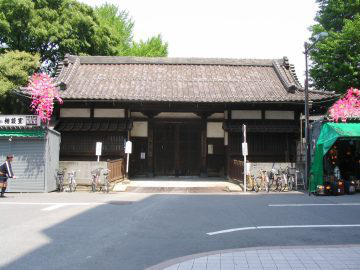
04. Denbo-in
Senso-ji Temple, 2 chome 3, Asakusa
Abbots serving to Senso-ji Temple dwell here in Denbo-in.
The main building was built in 1777 and here is held Sange-e in June and Shimotsuki-e in November annually. The former is for a Japanese Tendai sect anniversary, the latter for a Chinese one.
Behind this building is a garden with fountain created in the early part of the 17th century.
By the fountain, there is a temple bell which was cast in 1387 and also a teahouse called Tenyu-an which dates from the 18th century.
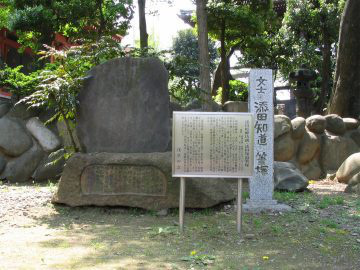
05. Monument of Soeda Azenbo and Fudezuka of Soeda Tomomichi
Senso-ji Temple, 2 chome 3, Asakusa
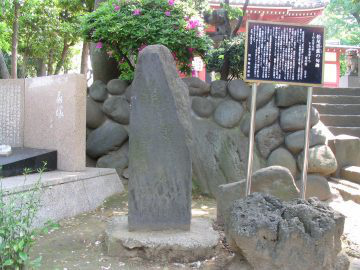
06. Monument of Matsuo Basho Inscribed with His Haiku
Senso-ji Temple, 2 chome 3, Asakusa
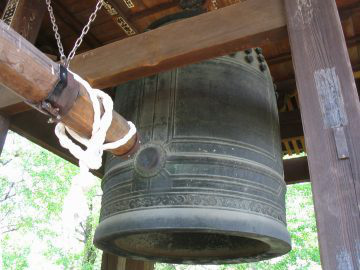
07. Bell of Time (Sensoji Temple)
Senso-ji Temple, 2 chome 3, Asakusa
It was the bell of time that played the role of informing the people of the time in the day during the Edo Period. As the result of Edo's expansion, bells came to be sounded at nine places including Nihonbashi Honkoku-cho, Senso-ji Temple and Ueno.
In connection with the sound of the bells, Matsuo Basho created the following haiku.
"Sounding through clouds of flower - is it the bell in Ueno or Asakusa?"
The present bell was recast under the instructions of Tokugawa Tunayoshi, the 5th shogunate, in August 1692. Measuring 2.12 meters in height and 1.52 meters in diameter, it still shows its original figure.
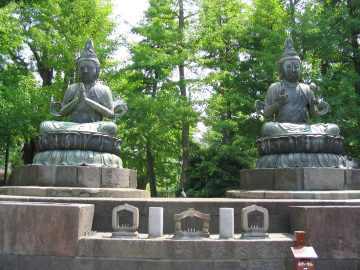
08. Two Buddhas
Senso-ji Temple, 2 chome 3, Asakusa
The two Statues are: Bodhisattva Avalokiteshvara on the right and Bodhisattva Seshi on the left. They are both 2.36 meters in height. In 1687, Takase Zenbee from Tatebayashi, (present Gunma Prefecture) made these statues to repay the debt of gratitude to the rice wholesaler family who helped him, the Avalokiteshvara for the father and the Seshi for the son.
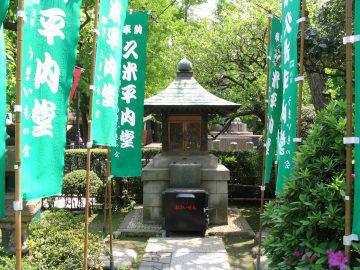
09. Kume-no-Heinai-do
Senso-ji Temple, 2 chome 3, Asakusa
Kume no Heinai was a samurai in the early Edo Period (17th century); he is said to have passed away in 1683, but there are many stories about his life and not many facts are known for certain.
According to oral tradition, Heinai excelled in Kenjutsu, the martial art of sword-fighting, and he killed many people over the years. Later in his life, he is said to have lived in the Kongo-in Temple in Senso-ji Temple, where he devoted himself to Zen-Buddhism and held religious services in honor of the souls of the people he killed.
It is said that, just before his death, he ordered his followers to carve his figure on a stone and bury it near Nio-mon (Deva gate), one of the busy districts of the city. He wanted his statue to be stepped on by as many people as possible in order to expiate the crimes he had committed in life. Afterward, the stone statue was eventually stored in this temple.
From the middle of the Edo Period, this temple was worshipped by the general public as a deity of marriage.
Kume-no-Heinai-do was burned down during the ravages of World War II in March 1945. The current temple was rebuilt in October 1978.
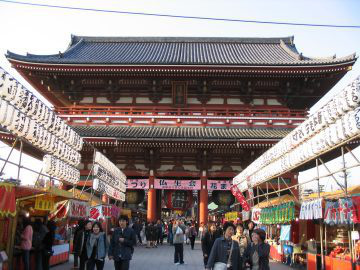
10. Hozo-mon
Senso-ji Temple, 2 chome 3, Asakusa
Hozo-mon Gate was built as a temple gate that also serves as storage of treasures for Senso-ji Temple. It was constructed in 1964 with donated money by Ohtani Yonetaro. The external appearance was designed in the style of the early Edo Period. It is a ferroconcrete gate, 21.7 meters in height, 21.1 meters in width and 8.2 meters in depth. Two wooden Nio (Deva Kings) statues made by Nishikido Shinkan and Muraoka Kyusaku are installed on the left and right sides of the front on the lower level.
It is said that the gate was first built by Taira no Kimimasa in 942. Since the Nio statues were enshrined, it has also been known as Nio-mon (Deva gate). After its creation, it has been burned down and rebuilt several times. The temple gate rebuilt in 1649 was a proud two-storied tower gate, which boasted a dignified appearance until it was burned down during air raids in 1945.
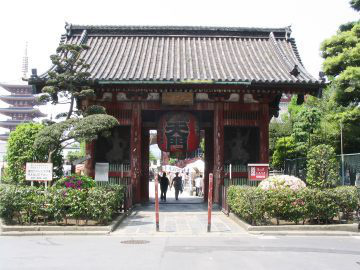
11. Niten-mon Gate
Important Cultural Properties
Senso-ji Temple, 2 chome 3, Asakusa
Toshogu Shrine was built in 1618 with this gate in the precincts of Senso-ji Temple. Toshogu Shrine burnt down in 1631 and 1642 with other temple edifices and pagodas. But the gate only remained intact.
Late in 19th century the figures in the gate were replaced with mid 17th century Buddhist figures: Jikokuten and Zochoten (guardians of the East and South). Then, the gate was renamed Niten-mon. These figures were moved from Kan-eiji Temple.
The gate was designated as a National Treasure in 1946 and as important Cultural Asset of the nation in 1950.
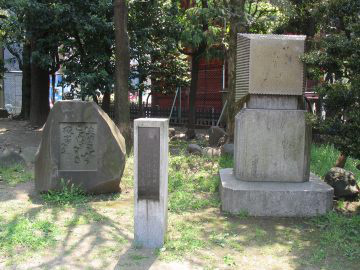
12. Monument to KawaguchiMatsutaro Inscribed with His Poem
Asakusa Shrine, 2 chome 3, Asakusa
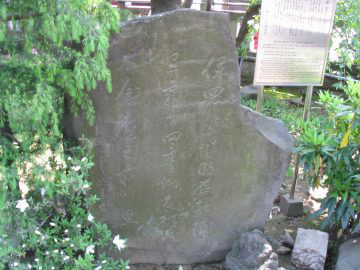
13. Monument to Yoso-oi-tayu (In memory of K.N.H. Miss Zuiun, using calligraphy inscribed one of his Waka poems on this monument)
Asakusa Shrine, 2 chome 3, Asakusa
Honobonoto Akasi no ura no asagiri ni
sima kakureyuku hune wo sizo omou
Honobonoto Akasi no ura no asagiri ni
sima kakureyuku hune wo sizo omou
The famous Man-yo poet, Kakinomoto no Hitomaro inscribed this poem in ancient Japanese phonetic characters (Man-yo-gana) using the calligraphy of Miss Zuiun, an intellectual of that period.
She was a courtesan and called Yoso-oi Tayu. Zuiun was her pen name. She was an excellent calligraphist, Waka poetess, and a cultured woman, who was often depicted in colored woodblock prints.
This monument was offered to Hitomaro-sha (a shrine to worship Kakinomoto no Hitomaro) in August of 1816 by Yoso-oi Tayu who adored Hitomaro. The shrine was destroyed after the Meiji Restoration, except for this monument which was move here in November of 1954.
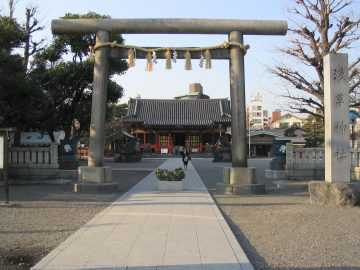
14. Asakusa Shrine
Important Cultural Properties
2 chome 3, Asakusa
The Asakusa Shrine had its origin in the joint enshrinement of Hinokuma no Hamanari, Hinokuma no Takenari, who picked up the image of Kannon, the main idol of the Senso-ji Temple, from the Sumida River, and Haji no Matsuchi, who made the image as the target of the people's worship.
The present shrine building was reconstructed by Tokugawa Iemitsu in December 1649. It is highly rated as the representative building of the Gongen structure of the early Edo Period, and has been designated as an important cultural asset of the nation. The Sanja Festival, held in May every year, is one of the three biggest festivals in Tokyo.
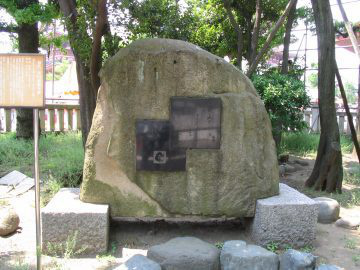
15. Monument to Ichikawa En-o the First Inscribed with His Poem
Asakusa Shrine, 2 chome 3, Asakusa
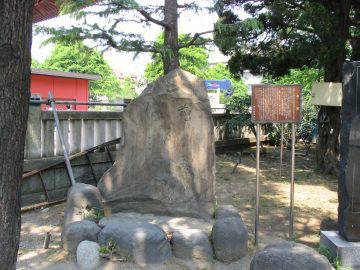
16. Hana-zuka (Mound of Flower)
Asakusa Shrine, 2 chome 3, Asakusa
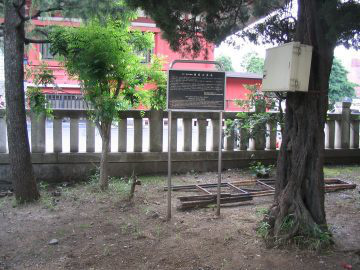
17. Remains of Farming of Edo, Tokyo - Umamaki of Hinokuma
Asakusa Shrine, 2 chome 3, Asakusa
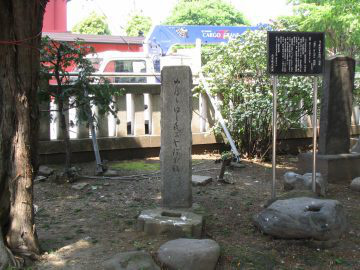
18. Monument to Nakamura Kichiemon the First Inscribed with His Poem
Asakusa Shrine, 2 chome 3, Asakusa
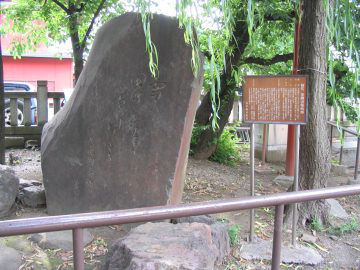
19. Short Biography of Hanayagi Jusuke the First
Asakusa Shrine, 2 chome 3, Asakusa
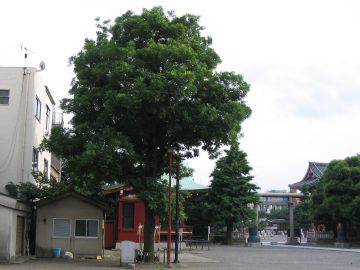
20. History of Sacred Tree "Enjyu" (Sophora Japonica)
Asakusa Shrine, 2 chome 3, Asakusa
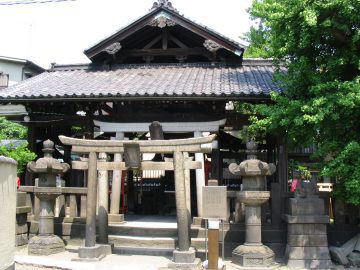
21. Hikan Inari Shrine
Asakusa Shrine, 2 chome 3, Asakusa
In 1854 when the wife of Shinmon Tatsugoro was bedridden with a serious illness, he prayed at Fushimi Inari-sha Shrine. She subsequently made a complete recovery and the following year to show his appreciation, he built a small shrine and called it Hikan Inari-sha Shrine. The derivation of this name is unclear, but "hikan" can be taken to have the meaning of "success in life".
The present shrine is the original one. It is approximately 1.5 meters by 1.4 meters and is sheltered by a covering roof.
Shinmnon Tatsugoro was active as the leader of the 10th division of the local fire brigade.
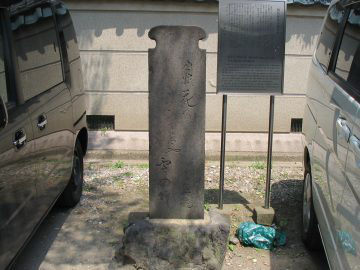
22. The Poem Monument of Namiki Gohei the First
Senso-ji Temple, 2 chome 3, Asakusa
"Tsuki hana no tawami kokoro ya yuki no take" the poem is inscribed on the front of the monument. On the right side of the monument is written the explanation of the origin of the poem. On the left side of the monument is the date of the monument's construction and the name of the monument's calligraphic artist. On the back of the monument is the name of the person who built the monument.
Namiki Gohei (1747-1808) was a famous Kabuki writer. He was well known for his historical dramas and dramas of contemporary life and manners of that genre.
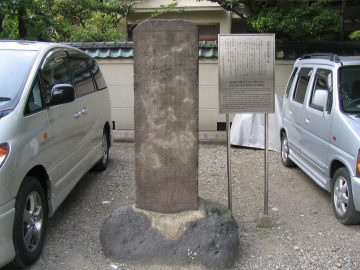
23. Monument of Mound Santo Kyoden's Desk
Taito City Tangible Cultural Property
Senso-ji Temple, 2 chome 3, Asakusa
Santo Kyoden was a man of letters in the Edo Period. He came to be known as Kyoden because his friends called him so since he was Denzo living in Kyobashi, Edo.
In the upper part of the monument, the title letters are inscribed, and the reason for creating the mound is explained. It says to the effect “At the age of 9 in February 1769, he entered a private school. Throughout his life, he loved the desk bought by his father on that occasion and wrote more than 100 volumes of fiction on the desk. As the desk was used for nearly 50 years, it came to be warped as was expected. It really causes us to feel pathos that it got old together with Kyoden.”
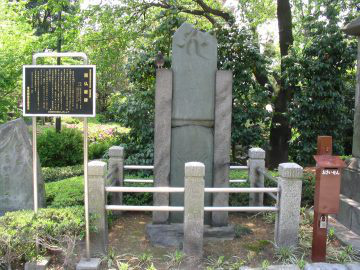
24. Saibutsu Itabi
Metropolitan Historic Site
Senso-ji Temple, 2 chome 3, Asakusa
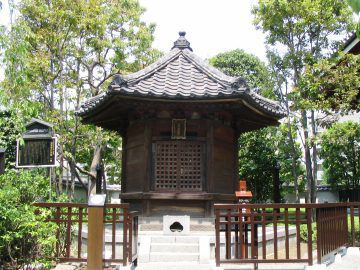
25. Senso-ji Rokkaku-do Temple
Metropolitan Historic Site
Senso-ji Temple, 2 chome 3, Asakusa
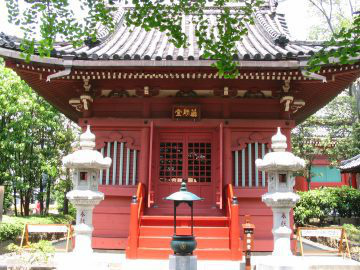
26. Hashimoto Yakusi-do Temple
Senso-ji Temple, 2 chome 3, Asakusa
This is a temple which houses a seating figure of Yakushi Nyorai (Physician of Souls). In 1649 it was reconstructed near a bridge, since then it has been called Hashimoto Yakusi-Do: a Yakushi Nyorai Temple of worship at the foot of a bridge.
This temple was built in the precincts of Senso-ji Temple following Niten-mon Gate (important national cultural asset), and Rokkaku-Do Temple (metropolitan tangible cultural asset), and of the same era as Asakusa Shrine (important national cultural asset).
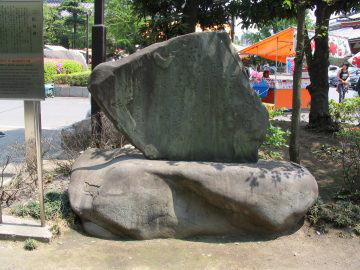
27. Monument in Memory of Sansho(Three Haiku Master Poets)
Senso-ji Temple, 2 chome 3, Asakusa
In the late 17th century, three Haiku masters: NISIYAMASOIN,
MATSUO BASHO, and TAKARAI KIKAKU inscribed haiku poems on this monument. It was erected in 1809 and moved here in 1894, the reason of why they moved it is inscribed on the base stone. The inscription has to be read from right to left as follows:
Nagamu tote hana nimo itasi kubi no hone SOIN
Hana no kumo kane ha Ueno ka Asakusa ka BASYO
Yukumizu ya nani ni todomaru nori no aji KIKAKU
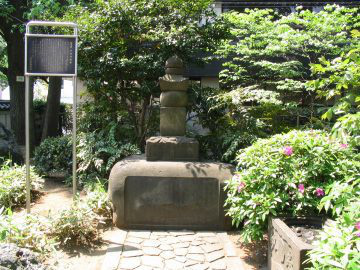
28. Tomb of Toda Mosui
Metropolitan Historic Site
Senso-ji Temple, 2 chome 3, Asakusa
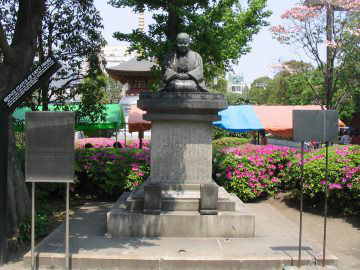
29. Bronze Statue of Uryu Iwako
Senso-ji Temple, 2 chome 3, Asakusa
Uryu Iwako was born in Kitakata, Fukushima Prefecture on February 15, 1829. Iwako was her popular name, and her real name was Iwa. At the age of 9, she lost her father, and her mother went back to her parents' home together with Iwa. When she was 14, she was entrusted to her aunt, and was educated by her uncle-in-law, who was a doctor in the Aizu Clan.
After the Meiji Restoration, she exerted efforts for the education of young girls in the Aizu Clan and also established the Fukushima Relief Facility for the assistance to the poor and orphans. She also founded the midwifery research institute and the Saisei Hospital in Wakamatsu, thereby promoting social work. She died in Fukushima on April 19, 1897. To praise the good conduct of Iwa, who devoted her whole life to charitable work, this bronze statue of her was erected here in April 1901.
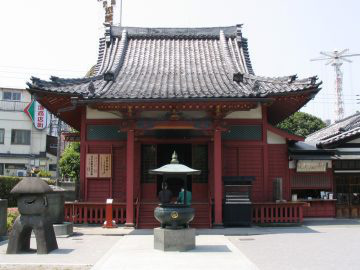
30. Awashima-do
Senso-ji Temple, 2 chome 3, Asakusa
Awasima-do was built in the late 17th century to worship a god called Sukunahikonano-mikoto who is enshrined at Kada shrine in Wakayama Prefecture. This god is famous as a guardian of women. Especially during "needle memorials" when women express gratitude by bringing used sewing needles and sticking them into Tofu (bean curd), the shrine attracts a lot of people.

















